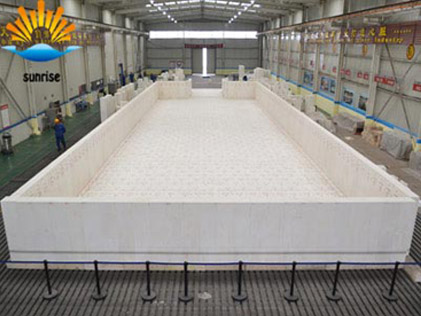Product
Fused Cast AZS Block
AZS Casting Type
AZS Ramming Materials
Fused Cast AZS TY-AZS41
Fused Cast AZS TY-AZS36
Fused Cast AZS TY-AZS33
Fused Cast Alumina Block
Fused cast Alumina Block TY-H
Fused cast Alumina Block TY-A
Fused cast Alumina Block TY-M
Fused Cast High Zirconia Block
Fused Cast Skid Rail Block
Silica brick
Magnesia Series Brick
Bonded Refractory Block
High alumina And Fire clay bricks
Insulation Series Brick
Ceramic Fiber Products
Contact Details
- 0086 371 63838939
- 0086 371 63835539
- sales@sunriserefr.com
- tkfanyi
- No.36 Fengchan Road, Zhengzhou City
Solutions
Thermal Conductivity Of Refractory Materials
- More related products
- Fused Cast AZS Block
- Fused Cast Alumina Block
- Fused Cast High Zirconia Block
- Fused Cast Skid Rail Block
Thermal conductivity is the amount of heat which flows from the hot face to the cold face of a refractory lining. It plays an important and critical role in the performance of refractory materials in structures such as high temperature process vessels, furnaces, kilns, etc.
Thermal conductivity is one of the important properties of refractory material since it determines the amount of heat transmission or heat loss due to radiation through it. It indicates general heat flow characteristics of the refractory and depends upon the chemical and mineralogical compositions as well as the application temperature.
In industrial operations, refractory materials of both high thermal conductivity and low thermal conductivity are required, depending on the types of furnaces.
Low thermal conductivity refractory materials are required if head losses are kept to a minimum for lining the walls of blast furnace, copper hearth furnace etc. because they minimize the heat losses to outside radiation and help in the maintenance of high temperatures inside the furnaces.
On the other hand, a good heat conductivity of refractory is desirable for effective heat transmission in some furnace construction, as coke oven walls, regenerators, muffles and water cooled furnace walls.
Porosity is a significant factor in heat flow through refractories. The thermal conductivity of a refractory decreases on increasing its porosity. The densest and least porous brick have the highest thermal conductivity, owing to the absence of air-voids. On the other hand, in porous bricks, the entrapped air in the pores, acts as a non-heat conducting material. The thermal conductivity is lower if the volume of air space is larger.
Thermal conductivity of the refractories is also expected to change after long-time exposure to high temperatures. Thermal conductivity values of the silica bricks will increase after their service.
Sunrise Refractory provides refractory materials of both high thermal conductivity and low conductivity for different industrial applications.
Read more
Need more information? Drop us a line
For more information on any of our products please get in touch using the form below. One of our sales team will respond to your enquiry as soon as possible.
Copyright © 2014 Zhengzhou Sunrise Refractory Co., Ltd. Site Index Product IndexSitemap










